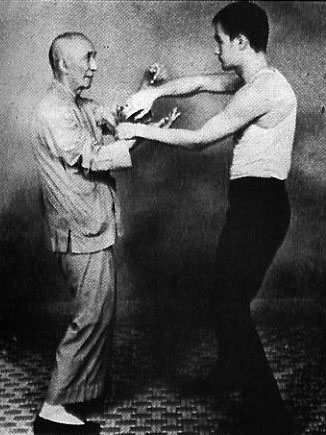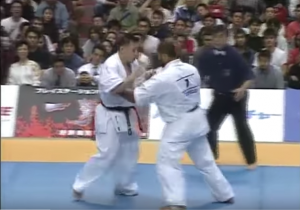Sometimes karate practice is just what you need. I have been going through bit of a personal struggle with my mind preoccupied. I was even considering skipping class at Contact Kicks Dojo last night, partly because I knew my troubles were written on my face and I didn’t want people to see or question. However, I decided it would be better for me if I did go, and I am so glad I did.
Yes, some people did ask me questions, but I could feel the their genuine support and concern, which was nice. The class itself was absolutely perfect for what I was going through, like Sensei Fogarasi had designed it so.

After an intense warm-up by one of the sempai, Sensei Fogarasi took us through some drills, which culminated in a variation of Sticking Hands. If you are not familiar with this, Sticking Hands (黐手 – Chi Sau in Chinese Cantonese, chī shǒu in Chinese Mandarin) is found in a few systems, but a large famous part of Wing Chun.
Sticking Hands is a term for the principle and drills used for the development of automatic reflexes upon contact and the idea of “sticking” to the opponent (also known as “sensitivity training”). In reality, the intention is not to “stick” to your opponent at all costs, but rather to protect your centerline while simultaneously attacking your opponent’s centerline.
Sensei explains that by “sticking” ones hands/arms to your opponents, he can feel where the opponent moves, what he is trying to do, when he is striking, etc. and counter accordingly just by feeling and without using his eyes (therefore decreasing reaction time and trapping the opponent).
Sensei also explains that the more calm and relaxed you are while doing the drill, the better you will perform and the faster and more naturally you can think and react.
The basic principles include:
- Maintain continuous contact with your opponents arms.
- Control your natural instinct to stiffen your muscles when you feel resistance. Resist with internal energy rather than external power.
- Relax
- Move your limbs, waist and spine in an integrated and unified manner.
- Change instantaneously from defence to attack, where half a movement is defence and half is attack.
- Remain well rooted. Your head should be light, your waist should be supple and your legs should be stable. All of your power comes through your legs into your waist and projects from the limbs.
After performing single hand drills, and then double hand, we began a more “free spar” version, in a Kyokushin style. We are shown by Sensei how applicable this is to tournament Kyokushin, where often time opponents are “sticking” to one-another while trying to gain ground to attack, or score a point, and KO. You can see this in high-level Kyokushin tournaments often.
 Some fighters have utilized something similar in the past, including Hajimi Kazumi. He practices something called Taikiken (greatly inspired by Chinese Yi Quan), which has components of sticking hands, and has integrated the training into his karate practice and fighting style. Taikiken was founded by the Japanese Kenichi Sawai (1903 – 1988) after losing to Chinese Wang Xiangzhai (1885-1963) – inventor of Yi Quan himself. Impressed by the technique of Wang Sawai learned the Yi Quan with the student Wang Yao Zongxun and then to the master himself. Mas Oyama and his student Hatsuo Royama both studied Taikiken with Kenichi Sawai.
Some fighters have utilized something similar in the past, including Hajimi Kazumi. He practices something called Taikiken (greatly inspired by Chinese Yi Quan), which has components of sticking hands, and has integrated the training into his karate practice and fighting style. Taikiken was founded by the Japanese Kenichi Sawai (1903 – 1988) after losing to Chinese Wang Xiangzhai (1885-1963) – inventor of Yi Quan himself. Impressed by the technique of Wang Sawai learned the Yi Quan with the student Wang Yao Zongxun and then to the master himself. Mas Oyama and his student Hatsuo Royama both studied Taikiken with Kenichi Sawai.
I found the drill really amazing. I had done some Chi Sau in my past, and I loved how naturally it fit to this type of fighting. As Sensei stated, it might not be too applicable to the street, where you want to keep distance, end it and get out quickly, but for tournament style fighting it was very useful.
As for myself, my mind continued to drift to my personal problem, but the exercise would force me to re-centre and bring my mind back to the practice at hand. The exercise itself showed me also that the more calm and flexible I remain, both in the exercise and in my own personal life, the more likelihood of a preferable outcome. Pushing hard or pulling tight isn’t always the best approach. It reminds me of something someone very special said to me. If you squeeze a bar of soap in your hand, it will pop out. But if you relax and be gentle, it will remain in the palm.
Last night’s lesson from the the dojo is just another in a long list that I am always trying to apply to life.
OSU!
Here is a video of Hajime Kazumi teaching a similar technique (via: Super Karate):

Konichiwa Shihan-Sensei Tomarchio showed me this technique;Now years later I have a new understanding of it’s aplication.Full circle.